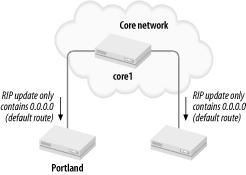Default Route
A routing table need not contain all routes in the network to reach all destinations. This simplification is arrived at through the use of a default route . When a router does not have an explicit route to a destination IP address, it looks to see if it has a default route in its routing table and, if so, forwards packets for this destination via the default route.
In RIP, the default route is represented as the IP address
0.0.0.0. This is convenient because
0.0.0.0 cannot be confused with any Class A, B, or
C IP address.
One situation in which default routes can be employed in an intranet is in a core network that has branch offices hanging off it (Figure 2-7).

Figure 2-7. Branch offices only need a default route
Consider the topology of this figure. Since the branch offices have only one connection (to the core), all routes to the core network and to other branches can be replaced with a single default route pointing toward the core network. This implies that the size of the routing table in the branch offices is just the number of directly connected networks plus the default route.
So, router Portland may be configured as follows:
hostname Portland ... interface Ethernet 0 ip address 192.100.1.17 255.255.255.240 ! interface Serial 0 ip address 192.100.1.33 255.255.255.240 ! router rip network 192.100.1.0
An examination of Portland’s routing table would show the following: ...
Get IP Routing now with the O’Reilly learning platform.
O’Reilly members experience books, live events, courses curated by job role, and more from O’Reilly and nearly 200 top publishers.

